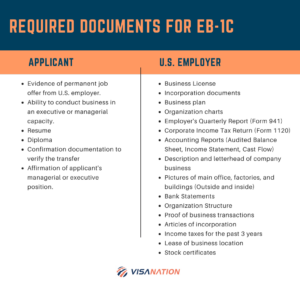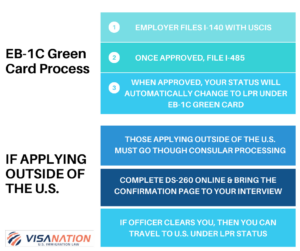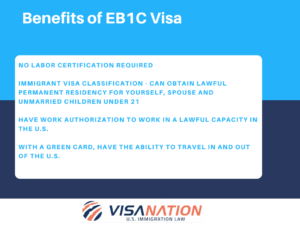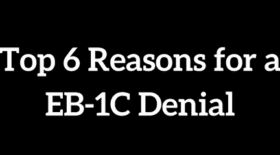The EB-1C for Multinational Managers is a first-preference employment-based immigrant category for multinational executives and managers seeking to obtain permanent residence (green card) in the United States. Learn all about this coveted green card, including the eligibility requirements, documents, application process, costs, and more.
A strong EB1-C case starts with the right legal strategy. Secure your consultation with a qualified attorney today.
EB-1C Overview
Are you a seasoned executive with a passion for spearheading teams across borders? In our rapidly evolving global economy, the EB-1C Multinational Managers’ category offers ambitious professionals an opportunity to navigate the international terrain of success.
Multinational executives and managers are a category within the Employment-Based (EB-1) Visa. The Employment-Based immigrant preference category was specifically created for multinational executives and managers interested in starting businesses in the United States.
This visa category also allows overseas companies to expand their business to the United States by permitting the overseas company to transfer executives and managers with direct knowledge of the company’s operations to the United States to assist with the start-up. In order to qualify as an Executive or Manager, certain requirements must be met.
EB-1C Requirements
Both the employer (petitioner) and employee (beneficiary) must meet strict criteria set by the USCIS to qualify or sponsor an EBC1 green card:
Employer Requirements
The U.S. employer must meet several requirements to successfully petition for an employee.
A. Business Operations
- The petitioning U.S. employer must have been actively doing business for at least one year.
- The employee must be transferred to an existing U.S. business. The EB-1C category cannot be used to open a new office.
- Both the U.S. employer and a qualifying foreign entity must continue to do business until the visa is granted.
- The petitioner must demonstrate the financial ability to pay the proffered wage
B. Qualifying Relationship
A qualifying corporate relationship must exist between the U.S. petitioner and the foreign entity where the employee worked. The primary types are:
- Parent-Subsidiary – One entity owns and controls the other.
- This can be more than 50% ownership, 50% ownership with control, or even less than 50% ownership if control can be proven.
- Affiliates
- Both entities are owned and controlled by the same parent or individual.
- Both entities are owned and controlled by the same group of people, with each person owning a similar proportion of each entity.
Employee (Beneficiary) Requirements
To meet EB-1C visa eligibility, the employee must meet specific criteria related to their prior employment and their proposed role in the U.S.
Prior employment
- The manager or executive must have been employed outside the United States with a qualified organization for 1 year out of the previous 3 years.
- Your role in the foreign company must have been in a managerial or executive capacity.
- This employment must have been with a qualifying foreign entity (parent, subsidiary, or affiliate) of the U.S. petitioner.
- Provide evidence that he/she is of managerial or executive capacity.
B. EB1C Job Offer Requirements
The job offer in the United States must be in a role that is primarily managerial or executive in nature:
- Managers must:
- Manage the organization or a department, subdivision, function, or component of the organization;
- Manage an essential function within the organization or a department or a subdivision of the organization;
- Function at a senior level within the organizational hierarchy or with respect to the function managed; and
- Exercise discretion over the day-to-day operations of the activity or function for which the employee has authority.
- Executives must:
- Direct the management of the organization or a major component or function of the organization;
- Establish the goals and policies of the organization, component, or function;
- Exercise wide latitude in discretionary decision making; and
- Receive only general supervision or direction from higher-level executives, the board of directors, or stockholders of the organization.
Tip: The EB1C is the perfect green card for L-1A managers and executives who are already in the U.S. under nonimmigrant status due to the fact that many of the EB-1C requirements are similar to that of the L-1A.
Required Documents for EB-1C
Each petition for an EB-1C must be submitted with the proper evidence to demonstrate that the U.S. company, foreign company, and beneficiary qualify:
A. The U.S. Company (Petitioner) Documents
Corporate & Legal Documents
- Articles of Incorporation and Bylaws
- State/Local Business Licenses and Registrations
- Federal EIN (Tax ID) Letter
- Stock Certificates and Ledger
- Certificate of Good Standing
Purpose: To establish that the company is a legal entity in good standing.
Financial Documents
- Federal Corporate Tax Returns (last 2-3 years)
- Audited Financial Statements (Balance Sheets, Income Statements)
- Recent Business Bank Statements
- Major Contracts, Invoices, or Letters of Credit
Purpose: To prove the company is financially stable enough to support the executive position.
Operational & Personnel Documents
- Detailed Organizational Chart
- Payroll Records or Quarterly Wage Reports (Form 941)
- List of Employees with Job Titles
- Commercial Lease or Deed for Business Premises
- Photos of the Interior and Exterior of the Office/Facility
Purpose: To show the company is actively operating with a structure that requires a manager.
B. The Foreign Company (Qualifying Entity) Documents
Corporate & Operational Documents
- Business Registration / Incorporation Documents
- Proof of Ownership showing the link to the U.S. company
- Company Annual Reports
- Promotional Materials, Brochures, and Website Printouts
- Photos of the Business Premises
Purpose: To prove the entity is a legitimate, operational business linked to the U.S. company.
Financial Documents
- Corporate Tax Returns or Financial Statements (last 2-3 years)
Purpose: To confirm the foreign entity is a substantial, ongoing enterprise.
C. The Employee (Manager or Executive) Documents
Employment History & Role
- Employment Verification Letter detailing dates, titles, and duties
- Detailed Job Descriptions for both the foreign and U.S. roles
- Professional Resume or CV
- Employment Contracts or Offer Letters
Purpose: To verify the employee’s qualifying one-year experience and high-level responsibilities.
Evidence of Authority
- For Managers: Performance reviews conducted by the employee, team workflow charts.
- For Executives: Strategic plans authored, budgets controlled, board meeting minutes.
Purpose: To demonstrate the employee’s duties are genuinely managerial or executive.
Personal & Qualifying Documents
- Passport, Visa, and I-94 Copies
- Educational Degrees and Diplomas
Purpose: To confirm the employee’s identity and qualifications.
Important: The EB1C document checklist is not an exhaustive list. Work with an immigration attorney to determine which pieces of evidence are best to submit for your particular case.

How to Apply For EB-1C Green Card
Step One: Employer Files I-140, Immigrant Petition For Alien Worker
The first step to getting your EB-1C green card is to have your employer file an I-140 immigrant petition for an alien worker with the USCIS. After gathering all evidence and documentation, they will submit this form on your behalf.
Step Two: Wait for Priority Date to Become Current In The Visa Bulletin
The date your petition is filed is known as your “priority date.” The priority date is your place in line for a green card, as there is a cap on how many are offered annually. Once your priority date is current, meaning it matches or surpasses the date listed in the final action dates for employment-based preference cases, 1st preference.
Fortunately, for most countries, the final action date for 1st preference green cards is typically current or has a short waiting period.
China and India typically have a waiting period of a few years, but are much more favorable than 2nd and 3rd preference green cards.
Step Three: Apply for a Green Card
After your priority date is current, you will be able to apply for a green card. The process differs depending on whether you are based inside the United States on a valid nonimmigrant status or living abroad.
A. Living In the United States
If you are based inside the United States on a valid nonimmigrant status, you will file Form I-485 Application to Register Permanent Resident or Adjust Status.
Upon approval of the I-485, your status will automatically switch to legal permanent resident status under the EB-1C green card.
Important: Because the EB-1 category is often current for most countries, you can file the Form I-485 at the same time as the Form I-140. This is known as concurrent filing, and speeds up the green card process significantly.
- Along with filing this form, you will need to attend a medical appointment, a biometrics appointment, and file any related paperwork for work and travel.
- You may need to attend an interview, but this is often waived.
B. Consular Processing
If you are outside the U.S. when you apply, you will undergo consular processing. This involves
1. NVC processing
After U.S. Citizenship and Immigration Services (USCIS) approves your immigrant petition, your case is transferred to the Department of State’s National Visa Center (NVC). At this stage, you will be required to:
- Pay the necessary government processing fees.
- Complete and submit Form DS-260, the Online Immigrant Visa Application.
- Upload supporting civil documents, such as your passport, birth certificate, and police certificates.
2. Medical Appointment
Before your interview can be scheduled, you must complete a medical examination. This must be done with a clinic or physician specifically authorized by the U.S. embassy, known as a Panel Physician.
This exam is required to ensure you are not medically inadmissible. The results are sent directly to the consulate or given to you in a sealed envelope, which you must bring to your interview.
3. Embassy or Consulate Interview
- Once the NVC has received and approved all your documentation, they will schedule an interview for you at the U.S. embassy or consulate in your home country.
- You must attend this one-on-one appointment, bringing the confirmation page of your DS-260 and original copies of your civil documents.
- A consular officer will ask questions to verify your information and confirm your eligibility for the visa.
- If the officer clears you, then you will be able to travel to the U.S. under legal permanent resident status.
- An officer at the U.S. port of entry (border, seaport, or airport) will stamp your passport for entry with a temporary I-551. Your EB-1C green card will be mailed to you shortly.

EB-1C Processing Time
This timeline provides a timeline of the EB1C, from starting the process to receiving a green card in hand:
I-140 Processing Time
- The median I-140 processing Time is 7.9 months, according to USCIS data.
- This waiting time can vary depending on the assigned USCIS service center’s caseload.
- Using optional premium processing reduces this timeline to 45 business days.
I-485 Processing Time
- For those adjusting status, the median I-485 processing time is ~7 months. This can be filed concurrently with I-140 if your priority date is current.
Consular Processing
- If you are not currently in the U.S., the whole consular processing typically takes 5 to 6 months
- This time includes evidence gathering, document submission, document review, medical appointment, and an interview appointment with the embassy/consulate.
How Much Will it Cost?
The EB-1C green card has a few mandatory fees and additional costs:
Applying from within the U.S.
- I-140 basic filing fee: $715
- Employer’s responsibility.
- Asylum Fee: $600
- Employers responsibility
- This fee is reduced to $300 for employers with 25 or fewer employees and is $0 for non-profits.
- I-485 filing fee: $1,440
- Paid by either you or your employer
- If you want a work permit ($260) and travel permit ($630), these also have additional expenses
Applying from abroad
- I-140 basic filing fee: $715
- Employer’s responsibility.
- DS-260 fee: $345
- Your responsibility
Optional fees
- Premium processing fee: $2,805.
- This fee can be paid either by you or your employer
- Shortens I-140 processing time to 45 business days.
- Attorney fees: These may vary widely. We offer a flat fee for our services. Schedule a consultation to learn more.
Benefits of EB-1C Multinational Manager or Executive
There are several advantages of selecting the multinational manager and executive category over other green card options.
- EB1C does not require a PERM Labor Certification. Bypassing the labor certification process expedites the entire process.
- EB-1 visas, including the EB-1C, have a high priority status, meaning they are generally processed more quickly than other employment-based visa categories.
- EB-1C green card priority dates are often current or relatively short. This means that as soon as your I-140 is approved by the USCIS, a visa number will be available for you to submit your I-485. This is in contrast to some EB2 and EB3 categories that have a waiting time of up to several years.
- Successful applicants can bring their spouses and unmarried children under 21 to the U.S. as dependents.
- EB-1C Green Card holders are eligible to apply for U.S. citizenship after five years of permanent residency.
Alternatives to EB-1C Green Card
There are alternative options for foreign professionals who do not qualify based on the requirements of the EB-1C Multinational Executives and Managers Green Card.
- EB-1A Extraordinary Ability green card: designed for individuals who have demonstrated extraordinary abilities in fields such as science, arts, education, business, or athletics. Instead of focusing on the company’s structure like the EB-1C, the EB-1A focuses entirely on the person’s individual accomplishments.
- EB-2 National Interest Waiver (NIW) green card: allows individuals to self-petition if they can demonstrate that their work is in the national interest of the United States. These alternative categories provide avenues for talented individuals to pursue permanent residency in the United States based on their unique skills, achievements, or contributions.
- L-1A to EB1C Green Card: A manager comes to the U.S. on an L-1A visa to run a U.S. office. This is especially useful if the U.S. office is new. Once the U.S. office has been actively doing business for at least one full year, the company can then file an EB-1C petition for that manager to get a green card.
- The EB-2 Advanced Degree Professionals Green Card is suitable for individuals with advanced degrees or exceptional abilities in specific fields, who have a job offer from a U.S. employer.
- The EB-3 Skilled Workers and Professionals Green Card is intended for individuals with at least two years of experience or a bachelor’s degree in a specific occupation, with a U.S. employer sponsoring their application.
- The EB-4 Special Immigrant Visa category covers a range of individuals, including religious workers, broadcasters, certain Afghan or Iraqi nationals who have provided assistance to the U.S. government, and more.
- EB-5 Immigrant Investor Program offers a pathway to permanent residency for foreign investors who meet specific investment and job creation requirements. These alternatives provide diverse opportunities for employment-based immigration to the United States, catering to different skill sets, backgrounds, and circumstances.
Frequently Asked Questions
What is the EB-1C Multinational Executives and Managers Green Card?
The EB-1C category is designed for multinational executives and managers who are being transferred from a foreign affiliate to work permanently in the United States.
Who is eligible for an EB-1C Green Card?
Eligibility is limited to foreign nationals who have been employed as executives or managers with a qualifying multinational company for at least one year within the past three years.
What is considered a qualifying multinational company?
A qualifying multinational company is one that has a subsidiary, affiliate, or branch office in the United States and operates in a continuous, systematic, and substantial manner.
Is there a specific requirement for the executive or managerial position?
Yes, the applicant must have been employed in an executive or managerial capacity in the multinational company.
What is the process for obtaining an EB-1C Green Card?
The process involves filing an immigrant petition with the U.S. Citizenship and Immigration Services (USCIS) and, upon approval, applying for an immigrant visa or adjustment of status.
Can I self-petition for an EB-1C Green Card?
No, self-petitioning is not allowed for EB-1C category. A sponsoring employer is required.
How long does it take to obtain an EB-1C Green Card?
Processing times vary, but generally, it takes several months to receive a decision on the immigrant petition and several more months for the subsequent visa or adjustment of status process.
Are there any numerical limitations on EB-1C Green Cards?
No, there are no annual numerical limits (visa caps) for EB-1C category. This means that visas are generally available throughout the year.
Can my family members accompany me on an EB-1C Green Card?
Yes, your spouse and unmarried children under the age of 21 may be eligible for derivative immigrant visas or adjustment of status.
Is a labor certification required for an EB-1C Green Card?
No, the labor certification process, which is required for most employment-based immigrant categories, is not necessary for EB-1C petitions.
Can I work for any employer after obtaining an EB-1C Green Card?
While the EB-1C Green Card is job-specific, it allows flexibility within the sponsoring multinational company’s organizational structure, allowing for promotions or lateral moves.
Can I travel outside the United States while my EB-1C application is pending?
Yes, you can travel, but it is recommended to consult with an immigration attorney and follow appropriate procedures to avoid potential complications.
Can I include my dependents in the EB-1C application?
Yes, in the EB1C application, you can include your spouse and unmarried children under the age of 21.
What evidence is required to demonstrate qualifying employment for EB-1C?
Evidence such as job descriptions, organizational charts, payroll records, tax documents, and other supporting documentation should be provided to establish the qualifying employment.
Can I apply for an EB-1C Green Card if I have previously worked for a different company?
Yes, as long as you have been employed in an executive or managerial capacity for the qualifying multinational company for at least one year within the past three years.
What is the role of the U.S. employer in the EB-1C process?
The U.S. employer serves as the petitioner and sponsor for the foreign executive or manager, submitting the necessary forms and supporting documentation to initiate the process.
Are there any educational requirements for EB-1C eligibility?
No, there are no specific educational requirements for EB-1C eligibility. However, relevant work experience is crucial to establish executive or managerial capacity.
Can I change employers after obtaining an EB-1C Green Card?
While the EB-1C Green Card is job-specific, under certain circumstances, you may change employers as long as the new job continues to meet the executive or managerial requirements.
Can I apply for an EB-1C Green Card while in the United States on a nonimmigrant visa?
Yes, it is possible to apply for an EB-1C Green Card while in the United States on a valid nonimmigrant visa, but specific conditions and requirements must be met.
Can I apply for premium processing for my EB-1C petition?
Yes, premium processing is available for EB-1C petitions, which generally provides faster processing times for an additional fee.
How VisaNation Immigration Lawyers Can Help
Don’t leave your EB-1C green card to chance. A successful petition requires expert precision, and our attorneys specialize in delivering it.
VisaNation Law Group will thoroughly assess your eligibility, strengthen your documentation, and build a case designed for approval. We handle the complexities so you can focus on your success.
Ready to start? Fill out our simple contact form to schedule your consultation.




